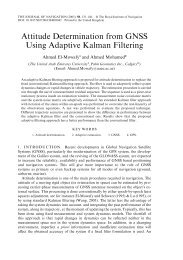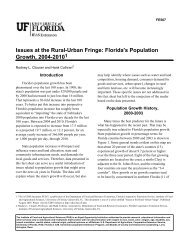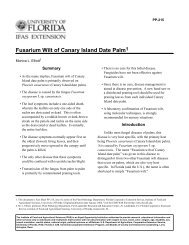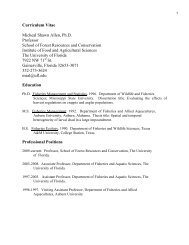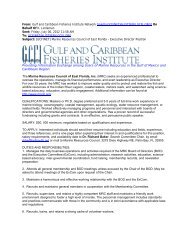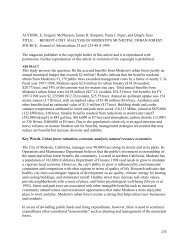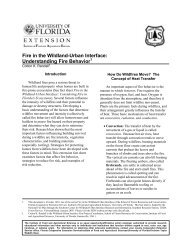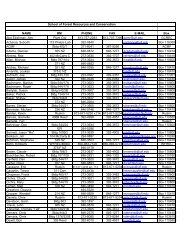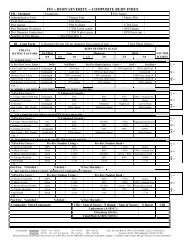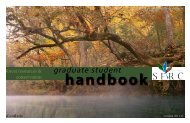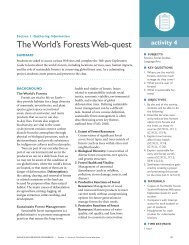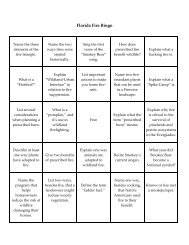Chapter 2: Implement<strong>in</strong>g a <strong>Restoration</strong> ProjectInvestigation <strong>of</strong> production enhanc<strong>in</strong>g strategies for wiregrassseed at <strong>the</strong> North Florida Research and Education Center <strong>in</strong>Marianna, FL. Credits: C. Mackowiak.Monitor<strong>in</strong>gEcological monitor<strong>in</strong>g methodologies are used to assess<strong>the</strong> status and detect change <strong>in</strong> populations, communities,and ecological systems over time. Monitor<strong>in</strong>g is essentialfor groundcover restoration <strong>in</strong> order to determ<strong>in</strong>e whe<strong>the</strong>rmanagement actions are hav<strong>in</strong>g <strong>the</strong>ir <strong>in</strong>tended impactand to ascerta<strong>in</strong> <strong>the</strong> need for future management actions.Develop<strong>in</strong>g an effective monitor<strong>in</strong>g protocol requiresthoughtful exam<strong>in</strong>ation <strong>of</strong> your restoration priorities andassociated measures <strong>of</strong> success. There are a number <strong>of</strong>resources available with descriptions <strong>of</strong> specific monitor<strong>in</strong>gprotocols and <strong>the</strong>ir uses (Pavlik 1996; Masters 1997; Elz<strong>in</strong>gaet al. 1998; Holl and Cairns 2002).For many groundcover restoration projects, success <strong>in</strong>cludesestablish<strong>in</strong>g a m<strong>in</strong>imum number <strong>of</strong> native plant species,reduc<strong>in</strong>g <strong>the</strong> cover <strong>of</strong> non-native species, and <strong>in</strong>creas<strong>in</strong>g <strong>the</strong>cover or density for a selected group <strong>of</strong> native groundcoverspecies. To determ<strong>in</strong>e whe<strong>the</strong>r success <strong>in</strong> <strong>the</strong>se criteriais obta<strong>in</strong>ed, restoration objectives must be def<strong>in</strong>ed <strong>in</strong>quantifiable terms (see Chapter 1). In order to develop agroundcover monitor<strong>in</strong>g plan, <strong>the</strong> follow<strong>in</strong>g questions needto be addressed:• What will be measured?• How will <strong>the</strong>se <strong>in</strong>dicators be measured?• What is <strong>the</strong> timeframe for tak<strong>in</strong>g repeated measurements?• What type <strong>of</strong> data analysis will be used?A first step <strong>in</strong> decid<strong>in</strong>g what to measure is identify<strong>in</strong>ga small number <strong>of</strong> factors that could serve as <strong>in</strong>dicators<strong>of</strong> restoration success. Data ga<strong>in</strong>ed from <strong>the</strong> referencecommunity for <strong>the</strong> identity, cover, and spatial distribution<strong>of</strong> native species appropriate to <strong>the</strong> restoration site can beused as a benchmark for <strong>the</strong> restoration site. The goals <strong>of</strong> <strong>the</strong>restoration and <strong>the</strong> botanical knowledge <strong>of</strong> <strong>the</strong> field crewwill help determ<strong>in</strong>e whe<strong>the</strong>r measurements will be takenfor each species, for a few previously identified key species,or simply by cover categories (grass, forb, shrub, and/ortree cover). Although it may be tempt<strong>in</strong>g to measure manyfactors as a precautionary measure so that an importantvariable is not left out, narrow<strong>in</strong>g <strong>the</strong> list to a few keyelements will greatly <strong>in</strong>crease monitor<strong>in</strong>g efficiency. Whenchoos<strong>in</strong>g what to measure, it is important to try to selectfactors known to be sensitive to management activities, toonly <strong>in</strong>clude relevant factors, and to ensure that <strong>the</strong> factorschosen are not redundant (measur<strong>in</strong>g <strong>the</strong> same th<strong>in</strong>g).These suggestions help m<strong>in</strong>imize <strong>the</strong> time, effort, and cost <strong>of</strong>monitor<strong>in</strong>g activities.Once <strong>the</strong> factors to measure are chosen, <strong>the</strong> restorationistmust decide how <strong>the</strong> selected <strong>in</strong>dicators will be monitored.The two ma<strong>in</strong> types <strong>of</strong> ecological data collection arequalitative (descriptive) and quantitative (numerical).The benefits <strong>of</strong> qualitative measurements are that <strong>the</strong>y areusually less time <strong>in</strong>tensive and <strong>the</strong>refore less expensive. Thedownsides <strong>of</strong> qualitative measurements are that <strong>the</strong>y aredependent on <strong>the</strong> person tak<strong>in</strong>g <strong>the</strong> measurements (moresubjective) and <strong>the</strong>refore can be less repeatable. Qualitativemeasurements <strong>in</strong>clude:• presence/absence• area encompassed by a community• rough estimates <strong>of</strong> numbers (on a log scale)• permanent photo-po<strong>in</strong>tsIn contrast, quantitative measurements are repeatableamongst different researchers and can be analyzedstatistically to determ<strong>in</strong>e whe<strong>the</strong>r <strong>the</strong> measured changesare “real” or simply due to chance. This requires thatall quantitative monitor<strong>in</strong>g approaches be done witha m<strong>in</strong>imum number <strong>of</strong> replicates (e.g., 30 1-m2 coverquadrats per community-type). These approaches are morelabor <strong>in</strong>tensive and <strong>of</strong>ten require specialized botanical andstatistical expertise. Quantitative measurements used <strong>in</strong>restoration monitor<strong>in</strong>g are:• abundance/density estimates• percent cover• number or percent <strong>of</strong> plants flower<strong>in</strong>g or fruit<strong>in</strong>g• biomass• demographic data collection which tracks <strong>the</strong> survival,growth, and reproduction <strong>of</strong> <strong>in</strong>dividual plantsAlthough monitor<strong>in</strong>g survival and/or growth <strong>of</strong> <strong>in</strong>troducedplants may seem adequate for assess<strong>in</strong>g <strong>the</strong> success <strong>of</strong> a| 24 |
Chapter 2: Implement<strong>in</strong>g a <strong>Restoration</strong> Projectrestoration project, <strong>the</strong> true measure <strong>of</strong> restoration successis susta<strong>in</strong>ed production <strong>of</strong> <strong>the</strong> <strong>in</strong>troduced species (Gordon1994). For this reason, monitor<strong>in</strong>g over a short term is notnearly as tell<strong>in</strong>g as monitor<strong>in</strong>g over a longer term.Once your monitor<strong>in</strong>g protocol is <strong>in</strong> place, <strong>the</strong> next decision<strong>in</strong>volves development <strong>of</strong> a timeframe for monitor<strong>in</strong>g. Formany vegetation monitor<strong>in</strong>g protocols, <strong>the</strong> time <strong>of</strong> <strong>the</strong> yearwill <strong>in</strong>fluence which species are present and <strong>the</strong> percentcover that <strong>the</strong>y achieve. For this reason, most monitor<strong>in</strong>g isdone dur<strong>in</strong>g <strong>the</strong> grow<strong>in</strong>g season. In contrast, many rare or<strong>in</strong>vasive species are most easily identified when <strong>in</strong> flower orfruit, and monitor<strong>in</strong>g for <strong>the</strong>se species should be done at <strong>the</strong>time most conducive to <strong>the</strong>ir identification. In addition toseasonal affects, monitor<strong>in</strong>g should be repeated at <strong>in</strong>tervalsthat are useful to <strong>the</strong> restoration goals. For example, if seedshave just been <strong>in</strong>troduced to <strong>the</strong> site, monitor<strong>in</strong>g shouldoccur regularly at short <strong>in</strong>tervals if <strong>the</strong> goal is to determ<strong>in</strong>egerm<strong>in</strong>ation percentages. In contrast, when monitor<strong>in</strong>g <strong>the</strong>survival <strong>of</strong> outplant<strong>in</strong>gs, <strong>the</strong> first month will show <strong>the</strong> mostchange and <strong>the</strong>n bi-annual or yearly monitor<strong>in</strong>g shouldsuffice unless an unexpected climatic event (e.g., droughtor hurricane) has occurred or a restoration activity (e.g.,prescribed fire or herbicide) has been <strong>in</strong>troduced <strong>in</strong>to<strong>the</strong> site. In conclusion, <strong>the</strong> timel<strong>in</strong>e for monitor<strong>in</strong>g musttake <strong>in</strong>to account <strong>the</strong> biology <strong>of</strong> <strong>the</strong> species <strong>of</strong> <strong>in</strong>terest andmust ga<strong>the</strong>r <strong>the</strong> data needed to make <strong>in</strong>formed decisionsregard<strong>in</strong>g <strong>the</strong> need to change management strategies.F<strong>in</strong>ally, <strong>the</strong> goal <strong>of</strong> monitor<strong>in</strong>g is to be able to understandhow a restoration activity affects plant community presence,composition, and/or structure. When choos<strong>in</strong>g monitor<strong>in</strong>gprotocols, it is important to understand what types <strong>of</strong>data analysis will be necessary to make <strong>the</strong> data collectedunderstandable and useful. For species presence/absencedata this can be as simple as a list <strong>of</strong> native species foundor a graph <strong>of</strong> <strong>the</strong> number <strong>of</strong> native species through time.For quantitative data on density or cover, graphs <strong>of</strong> changesover time can be employed. If different restoration activitieshave been conducted with<strong>in</strong> <strong>the</strong> site, <strong>the</strong> responses amongplots can be compared statistically us<strong>in</strong>g a t-test or ANOVA.F<strong>in</strong>ally, when rare species are monitored or when hav<strong>in</strong>gpredictive power <strong>of</strong> <strong>the</strong> future health or status <strong>of</strong> populationsis <strong>of</strong> <strong>in</strong>terest, an analysis <strong>of</strong> demographic data us<strong>in</strong>g matrixmodels should be employed (Caswell 2006; Masch<strong>in</strong>ski andDuquesnel 2006).The Society <strong>of</strong> Ecological <strong>Restoration</strong> International (SER)developed a Primer that recommends 9 ecosystem attributesworthy <strong>of</strong> consideration when assess<strong>in</strong>g if restoration effortshave been successful (SER 2004). These attributes can belumped <strong>in</strong>to 3 categories: vegetative diversity, vegetativestructure, and ecological processes. Time <strong>in</strong>vested <strong>in</strong> carefulconsideration <strong>of</strong> exactly which <strong>of</strong> <strong>the</strong>se characteristics ismost appropriate for def<strong>in</strong><strong>in</strong>g success <strong>in</strong> a particular projectbefore work is <strong>in</strong>itiated will be time well spent.| 25 |



